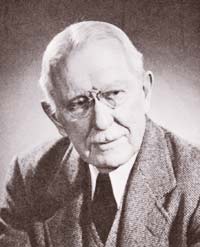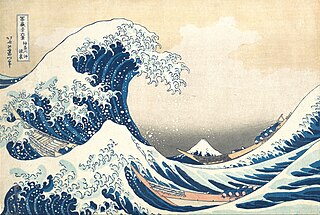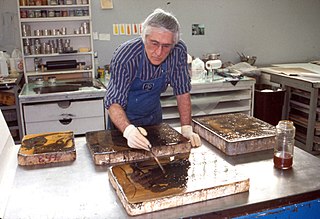Related Research Articles

Printing is a process for mass reproducing text and images using a master form or template. The earliest non-paper products involving printing include cylinder seals and objects such as the Cyrus Cylinder and the Cylinders of Nabonidus. The earliest known form of printing as applied to paper was woodblock printing, which appeared in China before 220 AD for cloth printing. However, it would not be applied to paper until the seventh century. Later developments in printing technology include the movable type invented by Bi Sheng around 1040 AD and the printing press invented by Johannes Gutenberg in the 15th century. The technology of printing played a key role in the development of the Renaissance and the Scientific Revolution and laid the material basis for the modern knowledge-based economy and the spread of learning to the masses.

Movable type is the system and technology of printing and typography that uses movable components to reproduce the elements of a document usually on the medium of paper.

Woodcut is a relief printing technique in printmaking. An artist carves an image into the surface of a block of wood—typically with gouges—leaving the printing parts level with the surface while removing the non-printing parts. Areas that the artist cuts away carry no ink, while characters or images at surface level carry the ink to produce the print. The block is cut along the wood grain. The surface is covered with ink by rolling over the surface with an ink-covered roller (brayer), leaving ink upon the flat surface but not in the non-printing areas.

The Kelmscott Press, founded by William Morris and Emery Walker, published 53 books in 66 volumes between 1891 and 1898. Each book was designed and ornamented by Morris and printed by hand in limited editions of around 300. Many books were illustrated by Edward Burne-Jones. Kelmscott Press books sought to replicate the style of 15th-century printing and were part of the Gothic revival movement. Kelmscott Press started the contemporary fine press movement, which focuses on the craft and design of bookmaking, often using hand presses. While their most famous books are richly decorated, most Kelmscott Press books did not have elaborate decoration, but were published simply.

Woodblock printing or block printing is a technique for printing text, images or patterns used widely throughout East Asia and originating in China in antiquity as a method of printing on textiles and later paper. Each page or image is created by carving a wooden block to leave only some areas and lines at the original level; it is these that are inked and show in the print, in a relief printing process. Carving the blocks is skilled and laborious work, but a large number of impressions can then be printed.
Rare Book School (RBS) is an independent 501(c)(3) non-profit organization based at the University of Virginia. It supports the study of the history of books, manuscripts, and related objects. Each year, RBS offers about 30 five-day courses on these subjects. Most of the courses are offered at its headquarters in Charlottesville, Virginia but others are held in New York City, Washington, D.C., and Baltimore, Maryland. Its courses are intended for teaching academics, archivists, antiquarian booksellers, book collectors, conservators and bookbinders, rare book and special collections librarians, and others with an interest in book history.

Rudolf Koch was a German type designer, professor, and a master of lettering, calligraphy, typography and illustration. Commonly known for his typefaces created for the Klingspor Type Foundry, his most widely used typefaces include Neuland and Kabel.

Printing in East Asia originated from the Han dynasty in China, evolving from ink rubbings made on paper or cloth from texts on stone tables used during the Han. Printing is considered one of the Four Great Inventions of China that spread throughout the world. A specific type of printing called mechanical woodblock printing on paper started in China during the Tang dynasty before the 8th century CE. The use of woodblock printing spread throughout Asia, and the idea of printing perhaps spread to Europe, where German publisher and inventor Johannes Gutenberg improved on the design with the introduction of the mechanical press in the mid-15th century. As recorded in 1088 by Shen Kuo in his Dream Pool Essays, the Chinese artisan Bi Sheng invented an early form of movable type using clay and wood pieces arranged and organized for written Chinese characters. The use of metal movable type was known in Korea by the 13th century during the Goryeo period. In Korea the first movable types date from 1239/1240. A further discovery was made in 2009, and here the types were dated to the year 1377.

Bruce Rogers was an American typographer and type designer, acclaimed by some as among the greatest book designers of the twentieth century. Rogers was known for his "allusive" typography, rejecting modernism, seldom using asymmetrical arrangements, rarely using sans serif type faces, often favoring faces such as Bell, Caslon, his own Montaigne, a Jensonian precursor to his masterpiece of type design Centaur. His books can fetch high sums at auction.

Woodblock printing in Japan is a technique best known for its use in the ukiyo-e artistic genre of single sheets, but it was also used for printing books in the same period. Widely adopted in Japan during the Edo period (1603–1868) and similar to woodcut in Western printmaking in some regards, the mokuhanga technique differs in that it uses water-based inks—as opposed to western woodcut, which typically uses oil-based inks. The Japanese water-based inks provide a wide range of vivid colors, glazes, and transparency.

Print is an American design and culture website that began as Print, A Quarterly Journal of the Graphic Arts, in 1940, and continued publishing a physical edition through the end of 2017 as Print.

The history of printing starts as early as 3000 BC, when the proto-Elamite and Sumerian civilizations used cylinder seals to certify documents written in clay tablets. Other early forms include block seals, hammered coinage, pottery imprints, and cloth printing. Initially a method of printing patterns on cloth such as silk, woodblock printing for texts on paper originated in China by the 7th century during the Tang dynasty, leading to the spread of book production and woodblock printing in other parts of Asia such as Korea and Japan. The Chinese Buddhist Diamond Sutra, printed by woodblock on 11 May 868, is the earliest known printed book with a precise publishing date. Movable type was invented by Chinese artisan Bi Sheng in the 11th century during the Song dynasty, but it received limited use compared to woodblock printing. Nevertheless, the technology spread outside China, as the oldest printed book using metal movable type was the Jikji, printed in Korea in 1377 during the Goryeo era.

Kenneth E. Tyler, AO is a master printmaker, publisher, arts educator and a prominent figure in the American post-war revival of fine art, limited edition printmaking. Tyler established leading print workshops and publishing houses on both West and East coasts of the United States and made several innovations in printmaking technology. His technical expertise and willingness to experiment on a bold scale drew many famous and influential artists to his workshops, among them Frank Stella, Helen Frankenthaler, Roy Lichtenstein, David Hockney, Robert Rauschenberg, Anthony Caro and Jasper Johns. Ken Tyler remains active as an educator and promoter of fine art printmaking, and mentor of a younger generation of printers through his various training and collecting institutions in Singapore, Japan, Australia and the US. The largest collection of prints produced at Tyler's successive workshops is currently held by the National Gallery of Australia.
Gerrit Noordzij was a Dutch typographer, typeface designer, and author. He started teaching letters and calligraphy at the Royal Academy of Art in The Hague in 1960. Motivated to make type accessible to his students, he identified the stroke of the pen as the central idea in the making of letter forms. What began as a method to make his students into better graphic designers grew, in various iterations and publications, into a comprehensive approach to type design. The contrast cube became an iconic model of his ideas. Noordzij recognised the possibilities of the computer in type design early on. He encouraged his students to not only study the pens and their shapes, but also adopt a critical view on making digital tools. By the time Noordzij retired in 1990, his methods were in use in type classes and workshops all over the world. His book The Stroke has been translated in English, German, French, Italian, Spanish, Portuguese, Korean, Croatian and Russian. And of course, it has been the practical and theoretical foundation of the KABK TypeMedia master for over twenty years.

William Seltzer Rice was an American woodblock print artist, art educator and author, associated with the Arts and Crafts movement in Northern California.

The illustration of manuscript books was well established in ancient times, and the tradition of the illuminated manuscript thrived in the West until the invention of printing. Other parts of the world had comparable traditions, such as the Persian miniature. Modern book illustration comes from the 15th-century woodcut illustrations that were fairly rapidly included in early printed books, and later block books. Other techniques such as engraving, etching, lithography and various kinds of colour printing were to expand the possibilities and were exploited by such masters as Daumier, Doré or Gavarni.

Gods' Man is a wordless novel by American artist Lynd Ward (1905–1985) published in 1929. In 139 captionless woodblock prints, it tells the Faustian story of an artist who signs away his soul for a magic paintbrush. Gods' Man was the very first American wordless novel, and is considered a precursor of the graphic novel, whose development it influenced.

Alan Kitching RDI AGI Hon FRCA, is a practitioner of letterpress typographic design and printmaking. Kitching exhibits and lectures across the globe, and is known for his expressive use of wood and metal letterforms in commissions and limited-edition prints.
Kitaoka Fumio was a Japanese artist. He was trained in oil painting, and later became interested in woodblock printing.

Rob Roy Kelly was a design educator who established multiple design programs in the formative years of graphic design education at art schools and universities. Known as a collector and scholar of wood type, Mr. Kelly authored American Wood Type, 1828–1900 (1969). His comprehensive wood type collection now resides at the University of Texas.
References
- ↑ Harry Vernon Anderson (July 1990). Interior Design. Interior Design Division of Whitney Communications Corporation. p. 33.
- ↑ Bookways, Issue 10-16. W. Thomas Taylor, Incorporated. 1994. p. 10.
- ↑ How. Vol. 19, Issues 1-3. RC Publications. 2004. p. 50.
- ↑ The APHA Newsletter: A Publication of the American Printing History Association. The Association. 2008. p. 35.
- ↑ Ambrose, Gavin; Aono-Billson, Nigel (2017-09-07). Basics Graphic Design 01: Approach and Language. Bloomsbury Publishing. ISBN 9781350034235.
- ↑ "This Just In: Identity Manual Collection". letterformarchive.org. Retrieved 2019-06-10.
- ↑ Lisa Cyr; Lisa Hickey; Cheryl Dangel Cullen (1 March 2007). Little Book of Big Promotions. Rockport Publishers. pp. 13–. ISBN 978-1-61673-646-0.
- ↑ How. RC Publications. 2004. p. 50.
- ↑ The APHA Newsletter: A Publication of the American Printing History Association. The Association. 2008. p. 35.
- ↑ "Purdue Profiles: Dennis Ichiyama". www.purdue.edu. Retrieved 2019-06-10.
- ↑ Indiana Arts Commission (1987). Annual Report. Indiana Arts Commission. p. 32.
- ↑ Humanities. The Endowment. 1985.
- ↑ National Endowment for the Humanities, Twentieth Annual Report 1985. 1984. p. xxxviii.
- ↑ Graphic Design USA. (2003). American Graphic Design Awards. Visual Reference Publications. pp. 39–. ISBN 978-1-58471-028-8.
- ↑ Roland Turner (1985). The Annual Obituary. St. Martin's. p. 267. ISBN 9780912289533.
- ↑ "Contemporary Visions in Wood Type". Baseline Magazine.
- ↑ National Art Museum and Gallery Guide. Art Now, Incorporated. 1988. pp. CD–123.
- ↑ David E. Carter (1975). The Book of American Trade Marks. Century Communications Unlimited.
